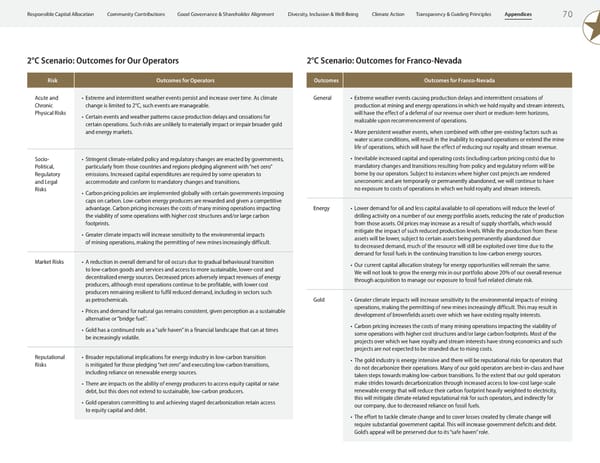Responsible Capital Allocation Community Contributions Good Governance & Shareholder Alignment Diversity, Inclusion & Well-Being Climate Action Transparency & Guiding Principles Appendices 70 2°C Scenario: Outcomes for Our Operators 2°C Scenario: Outcomes for Franco-Nevada Risk Outcomes for Operators Outcomes Outcomes for Franco-Nevada Acute and • Extreme and intermittent weather events persist and increase over time. As climate General • Extreme weather events causing production delays and intermittent cessations of Chronic change is limited to 2°C, such events are manageable. production at mining and energy operations in which we hold royalty and stream interests, Physical Risks • Certain events and weather patterns cause production delays and cessations for will have the effect of a deferral of our revenue over short or medium-term horizons, certain operations. Such risks are unlikely to materially impact or impair broader gold realizable upon recommencement of operations. and energy markets. • More persistent weather events, when combined with other pre-existing factors such as water scarce conditions, will result in the inability to expand operations or extend the mine life of operations, which will have the effect of reducing our royalty and stream revenue. Socio- • Stringent climate-related policy and regulatory changes are enacted by governments, • Inevitable increased capital and operating costs (including carbon pricing costs) due to Political, particularly from those countries and regions pledging alignment with “net-zero” mandatory changes and transitions resulting from policy and regulatory reform will be Regulatory emissions. Increased capital expenditures are required by some operators to borne by our operators. Subject to instances where higher cost projects are rendered and Legal accommodate and conform to mandatory changes and transitions. uneconomic and are temporarily or permanently abandoned, we will continue to have Risks • Carbon pricing policies are implemented globally with certain governments imposing no exposure to costs of operations in which we hold royalty and stream interests. caps on carbon. Low-carbon energy producers are rewarded and given a competitive advantage. Carbon pricing increases the costs of many mining operations impacting Energy • Lower demand for oil and less capital available to oil operations will reduce the level of the viability of some operations with higher cost structures and/or large carbon drilling activity on a number of our energy portfolio assets, reducing the rate of production footprints. from those assets. Oil prices may increase as a result of supply shortfalls, which would • Greater climate impacts will increase sensitivity to the environmental impacts mitigate the impact of such reduced production levels. While the production from these of mining operations, making the permitting of new mines increasingly difficult. assets will be lower, subject to certain assets being permanently abandoned due to decreased demand, much of the resource will still be exploited over time due to the demand for fossil fuels in the continuing transition to low-carbon energy sources. Market Risks • A reduction in overall demand for oil occurs due to gradual behavioural transition • Our current capital allocation strategy for energy opportunities will remain the same. to low-carbon goods and services and access to more sustainable, lower-cost and We will not look to grow the energy mix in our portfolio above 20% of our overall revenue decentralized energy sources. Decreased prices adversely impact revenues of energy through acquisition to manage our exposure to fossil fuel related climate risk. producers, although most operations continue to be profitable, with lower cost producers remaining resilient to fulfil reduced demand, including in sectors such as petrochemicals. Gold • Greater climate impacts will increase sensitivity to the environmental impacts of mining • Prices and demand for natural gas remains consistent, given perception as a sustainable operations, making the permitting of new mines increasingly difficult. This may result in alternative or “bridge fuel”. development of brownfields assets over which we have existing royalty interests. • Gold has a continued role as a “safe haven” in a financial landscape that can at times • Carbon pricing increases the costs of many mining operations impacting the viability of be increasingly volatile. some operations with higher cost structures and/or large carbon footprints. Most of the projects over which we have royalty and stream interests have strong economics and such projects are not expected to be stranded due to rising costs. Reputational • Broader reputational implications for energy industry in low-carbon transition • The gold industry is energy intensive and there will be reputational risks for operators that Risks is mitigated for those pledging “net-zero” and executing low-carbon transitions, do not decarbonize their operations. Many of our gold operators are best-in-class and have including reliance on renewable energy sources. taken steps towards making low-carbon transitions. To the extent that our gold operators • There are impacts on the ability of energy producers to access equity capital or raise make strides towards decarbonization through increased access to low-cost large-scale debt, but this does not extend to sustainable, low-carbon producers. renewable energy that will reduce their carbon footprint heavily weighted to electricity, • Gold operators committing to and achieving staged decarbonization retain access this will mitigate climate-related reputational risk for such operators, and indirectly for to equity capital and debt. our company, due to decreased reliance on fossil fuels. • The effort to tackle climate change and to cover losses created by climate change will require substantial government capital. This will increase government deficits and debt. Gold’s appeal will be preserved due to its “safe haven” role.
 2023 ESG Report | Franco-Nevada Page 71 Page 73
2023 ESG Report | Franco-Nevada Page 71 Page 73